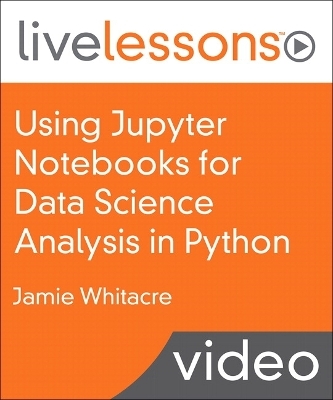
Using Jupyter Notebooks for Data Science Analysis in Python
Addison Wesley (Hersteller)
978-0-13-517314-5 (ISBN)
Create an end-to-end data analysis workflow in Python using the Jupyter Notebook and learn about the diverse and abundant tools available within the Project Jupyter ecosystem.
Overview
The Jupyter Notebook is a popular tool for learning and performing data science in Python (and other languages used in data science). This video tutorial will teach you about Project Jupyter and the Jupyter ecosystem and get you up and running in the Jupyter Notebook environment. Together, we’ll build a data product in Python, and you’ll learn how to share this analysis in multiple formats, including presentation slides, web documents, and hosted platforms (great for colleagues who do not have Jupyter installed on their machines). In addition to learning and doing Python in Jupyter, you will also learn how to install and use other programming languages, such as R and Julia, in your Jupyter Notebook analysis.
Skill Level
Beginner
Intermediate
Learn How To
Create a start-to-finish Jupyter Notebook workflow: from installing Jupyter to creating your data analysis and ultimately sharing your results
Use additional tools within the Jupyter ecosystem that facilitate collaboration and sharing
Incorporate other programming languages (such as R) in Jupyter Notebook analyses
Who Should Take This Course
Users new to Jupyter Notebooks who want to use the full range of tools within the Jupyter ecosystem
Data practitioners who want a repeatable process for conducting, sharing, and presenting data science projects
Data practitioners who want to share data science analyses with friends and colleagues who do not use or do not have access to a Jupyter installation
Course Requirements
Basic knowledge of Python.
Download and install the Anaconda distribution of Python here. You can install either version 2.7 or 3.x, whichever you prefer.
Create a GitHub account here (strongly recommended but not required).
If you are unable to install software on your computer, you can access a hosted version via the Project Jupyter website (click on “try it in your browser”) or through Microsoft’s Azure Notebooks.
About Pearson Video Training
Pearson publishes expert-led video tutorials covering a wide selection of technology topics designed to teach you the skills you need to succeed. These professional and personal technology videos feature world-leading author instructors published by your trusted technology brands: Addison-Wesley, Cisco Press, Pearson IT Certification, Prentice Hall, Sams, and Que Topics include: IT Certification, Network Security, Cisco Technology, Programming, Web Development, Mobile Development, and more. Learn more about Pearson Video training at http://www.informit.com/video.
Jamie Whitacre has more than 10 years of experience in scientific computing systems, informatics, data science, and data analysis. Her specialties include integrating research data and systems, streamlining data pipelines, and educating users about data workflows and tools. Jamie was a member of the Jupyter team 2016-2017 and regularly teaches on the topic as part of the Live Online Training program on Safari (www.safaribooksonline.com).
Introduction
Lesson 1: Project Jupyter and the Jupyter Ecosystem
Learning objectives
1.1 What are Project Jupyter and the Jupyter Notebook?
1.2 How Jupyter facilitates collaboration and sharing in data science
1.3 Differentiate between the Jupyter Notebook and other Jupyter projects
1.4 Find resources and connect with the Jupyter community through Jupyter.org
1.5 Learn through example using the Gallery of Interesting Jupyter Notebooks and GitHub
1.6 Contribute to the Jupyter ecosystem via GitHub
1.7 Participate in open source computing through NumFOCUS
Lesson 2: Creating Data Science Analyses in the Jupyter Notebook
Learning objectives
2.1 Determine which Python version to install
2.2 Install Jupyter using the Anaconda distribution of Python
2.3 Start your Jupyter Notebook using the command-line interface (CLI)
2.4 Start your Jupyter Notebook using the Anaconda Navigator
2.5 Run an ephemeral Interactive Jupyter Notebook on the web
2.6 Run Jupyter Notebooks in the cloud using Azure Notebooks
2.7 Run Jupyter Notebooks using Nteract
2.8 Navigate the Jupyter Notebook environment
2.9 Maintain good notebook hygiene
2.10 Perform quantitative exploratory data analysis (EDA) in your Jupyter Notebook using Python
2.11 Perform Visual Exploratory data analysis (EDA) in your Jupyter Notebook using Python
2.12 Create Jupyter Notebooks with different kernels (including R)
2.13 Install the R kernel
Lesson 3: Sharing Jupyter Notebooks
Learning objectives
3.1 Work with .ipynb files
3.2 Install nbconvert
3.3 Convert your Jupyter Notebook to different formats: HTML, PDF, and .py
3.4 Create dynamic presentation slides from your Jupyter Notebook using RISE
3.5 Share Jupyter Notebooks using GitHub and nbviewer
3.6 Access Jupyter Notebooks using Azure Notebooks
3.7 Compare and merge Jupyter Notebooks with nbdime
Lesson 4: Exploring New Jupyter Projects In-Depth
Learning objectives
4.1 Understand the basics of JupyterHub
4.2 Install and explore JupyterLab
4.3 Work with others using Real Time Collaboration
4.4 Enhance your analysis with interactive Jupyter Widgets
4.5 Share custom environments with Binder and BinderHub
Summary
| Erscheint lt. Verlag | 31.1.2022 |
|---|---|
| Reihe/Serie | LiveLessons |
| Verlagsort | Boston |
| Sprache | englisch |
| Themenwelt | Informatik ► Datenbanken ► Data Warehouse / Data Mining |
| Mathematik / Informatik ► Informatik ► Programmiersprachen / -werkzeuge | |
| ISBN-10 | 0-13-517314-0 / 0135173140 |
| ISBN-13 | 978-0-13-517314-5 / 9780135173145 |
| Zustand | Neuware |
| Informationen gemäß Produktsicherheitsverordnung (GPSR) | |
| Haben Sie eine Frage zum Produkt? |